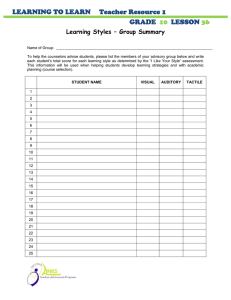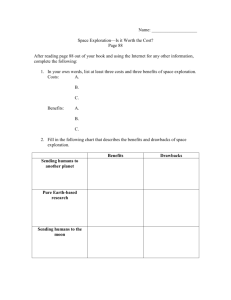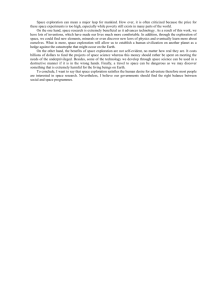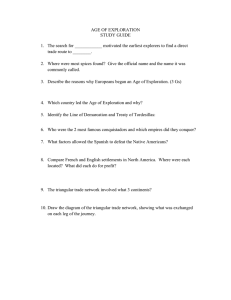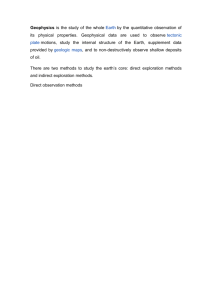Tactile robotic mapping of unknown surfaces: An Please share
advertisement
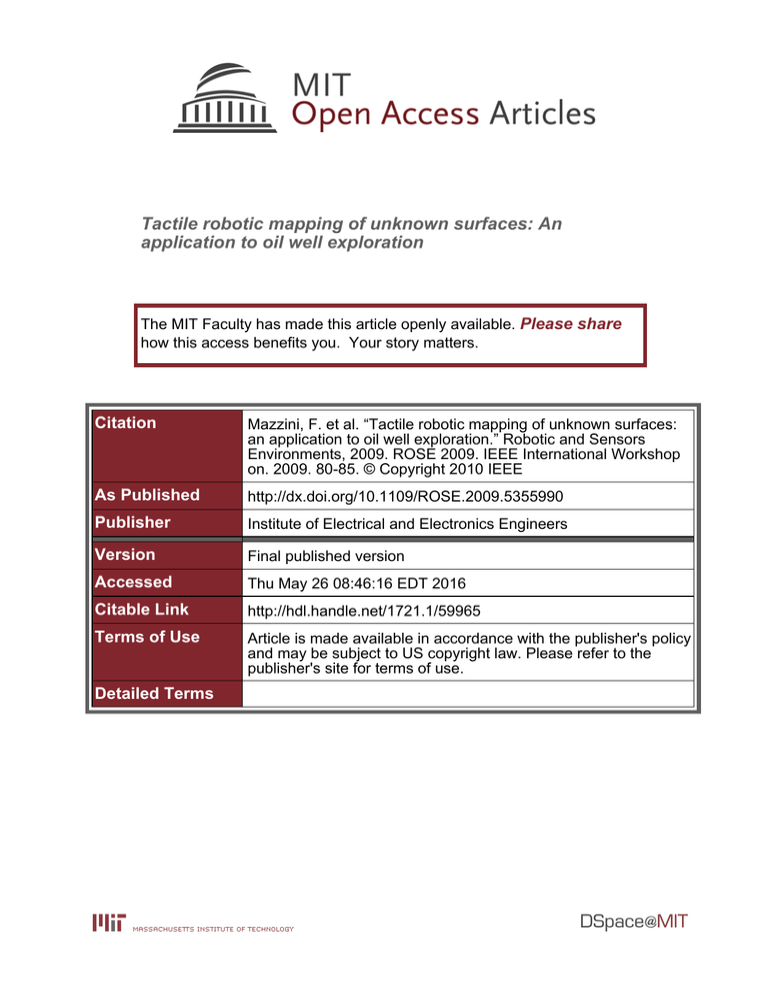
Tactile robotic mapping of unknown surfaces: An
application to oil well exploration
The MIT Faculty has made this article openly available. Please share
how this access benefits you. Your story matters.
Citation
Mazzini, F. et al. “Tactile robotic mapping of unknown surfaces:
an application to oil well exploration.” Robotic and Sensors
Environments, 2009. ROSE 2009. IEEE International Workshop
on. 2009. 80-85. © Copyright 2010 IEEE
As Published
http://dx.doi.org/10.1109/ROSE.2009.5355990
Publisher
Institute of Electrical and Electronics Engineers
Version
Final published version
Accessed
Thu May 26 08:46:16 EDT 2016
Citable Link
http://hdl.handle.net/1721.1/59965
Terms of Use
Article is made available in accordance with the publisher's policy
and may be subject to US copyright law. Please refer to the
publisher's site for terms of use.
Detailed Terms
Tactile Robotic Mapping of Unknown Surfaces:
an Application to Oil Well Exploration
Francesco Mazzini, Daniel Kettler and Steven Dubowsky
Julio Guerrero
Field and Space Robotics Laboratory
Massachusetts Institute of Technology
Cambridge, MA, 02139
{fmazzini,kettler,dubowsky}@mit.edu
The Schlumberger-Doll Research Laboratory
Cambridge, MA 02139
jguerrero1@slb.com
Abstract— World oil demand and advanced oil recovery
techniques have made it economically attractive to rehabilitate
previously abandoned oil wells. This requires relatively fast
mapping of the shape and location of the down-hole well
structures. Practical factors prohibit the use of visual and other
range sensors in this situation. Here, the feasibility of robotic
tactile mapping is studied. A method is developed that only uses
the robot joint encoders and avoids any force or tactile sensor,
which are complex and unreliable in such a hostile environment.
This paper addresses the general problem of intelligent tactile
exploration of constrained internal geometries where time is
critical. It is assumed that the time required to move a
manipulator to acquire a new touch point outweighs
computational time. This approach models the down-hole
structures with geometric primitives and focuses on exploration
efficiency by intelligently searching for new touch points to build
the geometric models. The algorithms developed here are shown
in simulations and hardware experiments to substantially reduce
the data acquisition effort for exploration with a tactile
manipulator.
Keywords- autonomous exploration, robotic mapping, tactile
sensing, surface reconstruction, oil-well exploration
I.
INTRODUCTION
Rising world oil demand and advanced oil recovery
techniques have made it economically attractive to rehabilitate
previously abandoned oil wells. This requires lowering
instruments and tools into the wells. These wells often have a
number of junctions where divergent branches leave the main
well at unrecorded depths (Figure 1). To rehabilitate an
abandoned branch, the location and shape of its junction needs
to be determined. The data acquisition to map a junction must
be done quickly given the very high cost of keeping a well out
of service (tens of thousands of dollars per hour).
Well mapping is challenging because the opaque fluids that
fill the well to avoid its collapse prevent the use of visual or
laser sensors to measure the junction. Ultrasonic sensors have
been suggested for this application, but studies have yet to
show that they posses the desired performance in down-hole
conditions. Also a layer of “mud cake” often obscures the well
bore surface. Consequently, robotic tactile exploration is
appealing. Here the feasibility of using a manipulator lowered
into the well to measure the junction location and geometry by
probing is studied in simulation and hardware experiments. The
mechanical design of a manipulator to function in the downhole environment of an oil well with its extreme temperatures
978-1-4244-4778-7/09/$25.00 ©2009 IEEE
is difficult and beyond the scope of this paper. Here the focus is
on the general problem of intelligent tactile exploration of
constrained internal geometries where time is a key factor.
Exploration and measurement using tactile data presents
unique challenges compared to using visual or other range
sensors. Obtaining tactile data is expensive in terms of time.
One visual image can very quickly provide thousands of data
points for an object surface. In comparison, the time for
moving a manipulator to acquire tactile data outweighs its
associated computation and processing costs. Hence, the key to
efficient tactile characterization is the intelligent selection of
where to search for new touch points.
In this work, a new strategy is proposed that is well suited
for the exploration of general unknown shapes in hostile
environments when time is a key issue. This work chooses the
oil well mapping as a representative case, but it uses a general
approach that can be applied also to similar situations such as
pipes, mines or nuclear facilities. This approach is based on the
use of surface fitting to characterize geometries, subject to the
assumption of sparse data collection. The environment to be
mapped is represented as the composition of a set of geometric
primitives. The approach continuously rebuilds the map as data
are acquired. The search for additional data points is directed
based on the information obtained at the current point in the
process. The objective is to minimize the time of the search,
and similarly the distance traveled by the manipulator end-
Figure 1. Typical oil well branching structure with cutaway detail of a
junction showing deployed tactile inspection manipulator
point, to reconstruct the unknown surface to a given accuracy.
This search should maximize the amount of new information
provided by each data point and thereby minimize the number
of data points needed to generate the map.
The proposed architecture is tested and compared in
simulations and hardware experiments. The results show the
effectiveness of the proposed search method in terms of time,
traveled distance and data points needed to map the unknown
surface.
A. Previous works
Studies on robotic tactile exploration have been driven by
research in different fields: robotic grasping and manipulation
[1], reverse engineering [2] and computational geometry [3].
Early studies developed techniques for locating and
identifying polygonal objects among a library of known models
[4]. In these works, the search for new data is selected to
reduce the possible object interpretations according to the
known library. More recent works in haptic exploration
identify local features on the object by analyzing the surface
curvature [1].
Approaches for general, unknown objects have also been
formulated. Interesting exploration strategies have been
developed describing the object surface with a mesh, and
guiding the robot motion to make this mesh arbitrarily dense
[3] [5] [6]. While a mesh is an effective representation of a
general surface, it requires dense data to completely represent a
generic object, and it is not efficient when the exploration time
is an essential factor. The same requirement occurs when a
spline is used to represent the object [7]. An alternative
approach represents surface geometry as a composition of
primitives, such as planes, cylinders and spheres. These
primitives are often determined with curve and surface fitting
methods [8]. Alternatively, they can be determined using
differential invariants [9]. All these methods use either a dense,
evenly spaced grid to collect data points, or assume that the
data have been previously collected. The importance of
intelligently selecting where to collect data for effective
exploration has been recognized in [2], but the method in this
work is still tied to a grid sampling concept and therefore
inherently uses dense data.
II. SENSORLESS ROBOTIC
UNKNOWN ENVIRONMENT
TACTILE MAPPING
OF
AN
Consider a manipulator inside an arbitrarily shaped
environment, with its base fixed to this shape, see Figure 2. The
objective is to tactily create a map of this environment with the
minimum travel by the robot. By touching the surface with its
tip, the robot autonomously collects data points and
reconstructs the shape within a given accuracy. The oil-well
junction mapping is a particular instance of this general
problem.
The manipulator is controlled with an impedance control
scheme [12]. This permits the robot to press against the
surfaces without any force or tactile sensors. Impedance control
is used to hold the manipulator probe against the environment.
The position of the probe tip and therefore the contact point on
the surface can then be determined just by sensing joint angles.
The absence of force sensors makes this approach inexpensive,
robust, and suitable for harsh environments.
In this work, the environment surface is assumed to be rigid
and composed of any combination, as in constructive solid
geometry, of the following primitives: planes, spheres,
cylinders, cones and tori. This choice is general enough to
represent a high number of surfaces (a survey by [13] indicates
that 95% of conventional objects can be represented by these
primitives), and it is easy to generalize to further shapes in case
these primitives prove to be insufficient. In fact, blends
between primitives can be implemented, and splines can be
locally used in situations where no primitive represents the real
shape.
This exploration and characterization architecture allows
for fast determination of large-scale elements of a general
geometry. This characterization can be used later to guide
intensive small-scale tactile exploration of designated areas of
interest, such as the lip of a junction in an oil well.
The overall goal of tactily mapping the shape of the
environment with a robot can be divided into two problems that
are solved simultaneously: surface reconstruction, dealing with
the representation of the shape, and exploration strategy,
dealing with the best exploring path for the robot.
With regard to the hardware needed for exploration, all the
studies mentioned use either a force-torque sensor, or an active
tactile probe. The method presented in this work only requires
information from joint encoders. Contact detection using only
data from joint encoders has been studied in the context of
multifinger grasping [10] [11]. Yet, these works study only
local contact detection, and not the issues of surface
reconstruction and exploration.
In conclusion, while different works studied intelligent
exploration, characterization of general unknown geometries,
and sensorless exploration, the integration of these concepts in
a unified method that allows the efficient exploration of hostile
environments remains yet totally unsolved.
Figure 2. Robot for tactile mapping in a generic environment
A.
Surface reconstruction
The objective of surface reconstruction is to best represent
the surface given the points touched on it. This process is
iterated every time a new point is measured and the surface
model is re-evaluated. Surface reconstruction has been well
studied in reverse engineering for large, dense datasets from
range sensors. This work adapts these techniques to small,
sparse datasets from tactile data.
As mentioned before, the surface is represented as a
combination of primitives. The parameters of these primitives
are determined with a least squares approach, minimizing the
sum of the squared distances between primitive and data points.
Different solutions for this problem, called surface fitting, have
been proposed [14] [15] [16]. Among these algorithms, tests
showed that the method in [16] worked the best for small and
sparse datasets characteristic of tactile exploration.
In order to correctly fit the data to different primitives,
these primitives need to be detected, and the points classified
so that each point belongs to only one primitive. This problem
is called range data segmentation. Among the several methods
proposed in literature, an approach called fit and grow has been
chosen and implemented [17]. It is based on the selection of
small initial regions to which all the possible primitives are
evaluated. Regions that give a good fit are then gradually
expanded. This approach is chosen because it best fits our
particular application where sparse points are added to the
dataset gradually, and outliers can be present when a primitive
has been just partially discovered.
After the primitives are identified, their intersections are
computed to produce the complete representations [18]. Care
must be taken, and some primitive parameters need to be
modified, in order to ensure that the boundary conditions
between primitives are consistent. This modification, called
constrained fitting, is necessary, for instance, when two
different primitives are tangent [19]. It has also been shown
that blends at the intersections can be determined with
relatively few touch points close to the intersections [20].
B.
Exploration strategy
An original strategy is proposed, which is well suited for
the tactile exploration of rough and constrained environments
such as oil wells. It is based on the collection of single probe
points over large surface areas, intelligently selecting these
points based on the partial interpretation of the surface being
discovered.
The use of discretely probed points, as opposed to a
continuous track of the robot tip along the surface, is chosen for
two reasons. First, oil-wells surfaces are rough and sometimes
covered with a thick and highly viscous material called mud
cake: this prevents the use of a continuous tracking strategy.
Secondly, measurements present noise, and primitives may be
locally deformed; therefore inferring a primitive from a small
local region is intrinsically unreliable, even if many data points
are used. In fact, simulations show that a reliable primitive fit
requires a long path, made of hundreds of such points if these
are taken consecutively along a continuous path (as confirmed
by [9]), while only a dozen points are sufficient if they are
sparse and well separated.
The guidance of the robot based on the continuous
interpretation of sequentially-acquired data is a key factor for
an efficient tactile mapping. An exhaustive search, where
points are probed in a fine grid, will be prohibitively time
consuming. To map the environment with a shorter end
effector path, and therefore in shorter time, a technique called
the Best Cone search has been developed. The concept is to
move the robot so that each measurement gives the most
information, as follows:
1.
The robot starts in a random direction.
2.
It sequentially probes (see below) a surface until a
primitive is identified to a desired accuracy.
3.
Then, the robot chooses another direction (as discussed
below), and moves along a line until it touches a new
point.
4.
If this point belongs to a known primitive, it will move
elsewhere as in (3), otherwise it will investigate and
identify the surface, as in (2), before continuing the search
in a new direction.
Step (2), called Uniform Surface Density (USD) search, is a
new strategy that probes points sequentially, one close to the
other, on the same surface. The arrangement of these points has
the objective of minimizing what is called dispersion, the
radius of the largest ball that does not contain points. On a twodimensional surface, dispersion is proved to be minimized
when points are disposed on a lattice of equilateral triangles
(cf. [21] for formal definitions). The robot tries to reproduce
this lattice structure on the unknown surface (Figure 3), simply
moving its tip on circular paths equidistant to two probed
points until it touches the surface.
Step (3) is critical to the method. The new direction is
chosen to maximize the expected amount of information given
by the next measurement. This approach has been studied in
SLAM literature, cf. [22] [23], and it resembles the problem
called Next Best View in computer vision [24] [25]. In this
work, a simple geometric method is proposed. This new
method has no proof of optimality but it performs very well in
simulations and experiments, with different shapes.
Conceptually, like a man who looks around and chooses to
explore where he has not yet been, the robot
chooses to move along the direction that is away from all
Figure 3. A representation of the Uniform Surface Density triangular
structure and of the Best Cone choice of direction.
previously touched points. To do this, it computes all the
possible circular cones with vertex at the end effector Pee and
subject to the constraint that all the probed points Pi are
external to the cone (Figure 3). Among these cones, the one
with biggest aperture angle is chosen, and its axis N is the next
exploration direction:
Pee Pi
N arg max
min N
Pee Pi
N
i
The internal minimization determines, for a given direction
N, the largest cone aperture angle that does not include any
touch point. The external maximization chooses N to maximize
this angle. This evaluation is computationally fast, because it
involves a search in just the variables representing the cone
axis. The primitives do not affect the choice. In some
applications, the intersections between primitives are important
regions and require more accuracy, which can be achieved with
detailed exploration along these intersections after the initial
identification.
III.
SIMULATIONS
The effectiveness of the algorithms has been evaluated in
two environments, the oil well junction and a generic shape
composed of a sphere, a cylinder and a plane (Figure 4). This
shape, although very simple, possesses different primitives,
requires constrained fitting between the cylinder and the
sphere, and presents a sharp intersection. Shapes used in these
simulations are ideal, but the measurements are corrupted by
random Gaussian noise with 1 mm standard deviation (σ).
The robot tip moves inside the environment, constrained by
the surface and by its workspace limits. The robot has no initial
knowledge of the shape to map. When it comes in contact with
the surface, the contact point is saved and the robot moves
somewhere else. The exploration terminates when the
environment is identified (within 1% of the correct
dimensions).
the whole environment with a certain density.
2. Random search: Every time the robot touches a point, it
then moves in a random direction.
3. Best Cone search: Described in the previous section.
4. Semi-random search: Like in the Best Cone strategy, USD
is locally used to identify primitives. However, once a
primitive has been identified, the new direction is selected
randomly.
For each strategy and environment, 20 simulation trials
were run. The means and standard deviations of the endeffector path lengths are shown in Figure 5. The results show
that for both environments the Best Cone strategy has the best
performance.
To be practical, a mapping procedure needs to be
sufficiently robust to identify shapes that are not ideal
primitives. The Best Cone strategy has been tested on irregular
surfaces where increasing random variations are added to the
surface. The algorithm always converges to the correct
primitives in all the trials when the noise (σ) is within 2% of
the cylinder radius, a rather large variation. The average
number of points does increase with increasing variation from
39 with 0.1% σ variation, to 51 points with 1% σ and 59 points
with 2% σ. With higher values of σ, the fitting and
segmentation procedure convergence is not always assured.
To study the effect of geometric non-idealities on the
methodology, the cylinder in the generic environment is given
an elliptical cross section. The Best Cone algorithm still proves
effective when the eccentricity is not extreme. For example,
with eccentricity 0.5 (i.e. major and minor axes are 107% and
93% of the original radius), the elliptical cylinder is identified
for 90% of the time as a cylinder. The algorithm is not given an
elliptical cross section cylinder as a primitive.
IV.
EXPERIMENTS
A.
System Description
In order to provide a comparison for the Best Cone search,
four strategies have been implemented and tested:
1. Uniform Surface Density (USD) search: it consists in the
iteration of step (2) of the Best Cone strategy, without
ever changing direction. It is designed to uniformly map
A laboratory system was designed [26] to test the
algorithms developed in this work, see Figure 6. The
Figure 4. Environments considered in simulation: Model of oil well junction
(left) and generic environment (right).
Figure 5. Mean end effector path lengths and standard deviations for both
environments and all four search strategies
4 degree-of-freedom (DOF) mechanism consisting of a 3 DOF
anthropomorphic arm attached to a long prismatic link aligned
with the axis of the main well bore is well suited. For
simplicity, in this experimental system only the 3 DOF arm has
been implemented, replacing the first prismatic joint with a
mounting ring that can be fixed at different heights. The sizing
of the arm links is based on of the workspace size and dexterity
requirement inside of an oil well. The manipulator links have
lengths of 20.32 cm and 15.24 cm, see Figure 7. The links are
stiff enough so that link deformations introduce negligible error
in the measured position of the probe tip.
Figure 6. Experimental robotic manipulator in model oil well junction
Each joint assembly consists of a motor, gear train,
encoder, and associated support bearings. Brushed DC motors
are used. The joints are compact in order to minimize the
potential for undesirable contact between the manipulator
elbow and environment. The joints are sealed by encasing them
within rubber bellows to protect them from drilling mud used
in oil wells. The manipulator has been used to test the system
and the control approach while submerged in fluids: water,
simulating properties of some lower-density oil well fluids, and
sucrose solutions with different concentrations, simulating
more viscous and dense well fluids [27].
B.
Experimental Results
Using the experimental system, a set of preliminary
experiments has been completed. The manipulator performance
has been characterized and several search methods have been
studied. With an appropriate backlash compensation method,
the manipulator provides sensing errors of roughly 1 mm.
Figure 7. Tactile probing manipulator
experimental system represents the size and kinematic
configuration of a well junction field system, given the
constraints of the laboratory. The environment tank is designed
to represent a scaled version of an oil well junction for
simulation and testing purposes.
The manipulator is controlled by a simple impedance
controller scheme [12]. Therefore, no force-torque or tactile
sensor needs to be mounted. This is a key element of the field
design, since building a force-torque sensor that can function
in the very hostile down-hole environment would be difficult
and prohibitively expensive.
Since the robot base is assumed fixed with respect to the
surface being explored, in the field system the robot will be
mounted on a cylindrical tool module that is lowered into the
well. This tool module will bind itself to the well bore above
the junction using expanding rubber mounts. Typical main and
lateral bores in well junction measure 23 cm and 18 cm in
diameter, with a divergence angle of 5°. This junction would be
approximately 203 cm long. The full exploration of this long
and narrow junction space requires a redundant manipulator. A
Figure 8 shows a comparison between the pattern of
experimental touch points produced by the USD and the Best
Cone strategies. The robot has no a-priori knowledge of the
environment or the kind of primitives involved, but the search
is terminated when the algorithm converges to two cylinders
with radius within 2% of the real value. Figure 8 also shows the
primitives fit to these touch points as well as the intersection.
Table 1 summarizes the results for these two strategies and the
semi-random search.
Using the USD search, the manipulator needed to travel 8.1
m to make these measurements over a period of 311 s. The
semi-random search presented similar results. The Best Cone
strategy led to better performance: the number of points was
reduced to 29 and the total distance traveled was reduced by
half. Similarly, the required time was reduced to 180 s. Figure
8 clearly shows the reduction on the number of touch points
using the Best Cone strategy.
The preliminary experimental results obtained to date
suggest that the proposed algorithms for the tactile exploration
of unknown environments are feasible, and an appropriate
exploration strategy greatly reduces the necessary time.
TABLE I.
Method
USD
Best Cone
Semi-random
Number of
points
68
29
67
EXPERIMENTAL RESULTS
Distance
traveled [m]
8.1
4.5
8.9
Time [s]
311
180
382
[3]
[4]
[5]
[6]
[7]
[8]
[9]
[10]
[11]
[12]
Figure 8. Result of exploration of oil-well junction using the Uniform
Surface Density search (top right) and the Best Cone strategy (bottom left).
[13]
[14]
V.
CONCLUSIONS
The objective of this research is to evaluate the feasibility
of using manipulator based tactile exploration of environments
where conventional range information is not feasible. A key
challenge in this concept is that the data from such exploration
is, in many cases, very sparse. Here data search and data
processing methods are developed to overcome this limitation.
The new approaches are tested in simulations and laboratory
experiments in the economically important context of mapping
the structure of deep-hole oil wells, and in particular mapping
the junctions where divergent lateral bores intersect the main
bore. This work proposes an original search method for tactile
exploration, based on the intelligent selection of touch points,
and on the representation of the surface as simple geometric
primitives. This method only requires a manipulator provided
with joint encoders, and no force or tactile sensor. Simulations
and laboratory experiments show that this method is feasible
and effective for tactile exploration, in terms of time, traveled
distance and data points needed to map the unknown surface.
Challenging issues of mechanical design presented by the very
hostile down-hole environment remain to be addressed.
[15]
[16]
[17]
[18]
[19]
[20]
[21]
[22]
[23]
[24]
REFERENCES
[1]
[2]
Okamura AM, Cutkosky MR, "Feature Detection for Haptic Exploration
with Robotic Fingers." The International Journal of Robotics Research.
20(12): 925, 2001.
Vosniakos G, Giannakakis T, ``Reverse engineering of simple surfaces
of unknown shape with touch probes: scanning and compensation
issues.'' Proc. Institution of Mechanical Engineers, Part B: J.Engineering
Manufacture. 217(4): 563-568, 2003.
[25]
[26]
[27]
Boissonnat, JD, Guibas LJ, Oudot S, "Learning smooth shapes by
probing." Computational Geometry: Theory and Applications. 37(1): 3858, 2007.
Roberts K, ``Robot active rouch exploration: constraints and strategies.''
Proc. IEEE Int. Conf. Robotics and Automation. 980-985, 1990.
Caselli S, Magnanini C, Zanichelli F, Caraffi E, ``Efficient exploration
and recognition of convex objects based on haptic perception.'' Proc.
IEEE Int. Conf. Robotics and Automation. 3508-3513, 1996.
Moll M, Erdmann MA, "Reconstructing the shape and motion of
unknown objects with active tactile sensors." Algorithmic Foundations
of Robotics V, J.-D. Boissonnat et al., editors, Springer-Verlag, Berlin,
pp. 293–309, 2004.
Charlebois M, Gupta K, Payandeh S, "Shape description of curved
surfaces from contact sensing using surface normals." The International
Journal of Robotics Research. 18(8): 779, 1999.
Allen P, Michelman P, ``Acquisition and interpretation of 3-D sensor data
from touch.'' IEEE Trans. Robotics and Automation. 6(4): 397-404, 1990.
Keren D, Rivlin E Shimshoni I, Weiss I, ``Recognizing 3D objects using
tactile sensing and curve invariants.'' J. Mathematical Imaging and
Vision. 12(1): 5-23, 2000.
Haidacher S, Hirzinger G, “Contact point identification in multi-fingered
grasps exploiting kinematic constraints.” Proc. IEEE Int. Conf. Robotics
and Automation, 2002, pp. 1597–1603.
Kaneko M, Tanie K, "Contact point detection for grasping an unknown
object using self-posture changeability." Robotics and Automation,
IEEE Transactions on. 10(3): 355-367, 2004.
Hogan N, ``Impedance control-an approach to manipulation: I-Theory.
II-Implementation. III-Applications.'' ASME J. Dynamic Systems,
Measurement, and Control. 107: 1-24, 1985.
Requicha A, Voelcker H, ``Solid modeling: a historical summary and
contemporary assessment.'' IEEE Computer Graphics and Applications.
2(2): 9-24, 1982.
Ahn S, “Least squares orthogonal distance fitting of curves and surfaces
in Space”. Heidelberg: Springer, 2004.
Lukacs G, Martin R, Marshall D, ``Faithful least-squares fitting of
spheres, cylinders, cones and tori for reliable segmentation.'' Lecture
Notes in Computer Science. Hiedelberg: Springer, 1998.
Jiang X, Cheng D, ``A novel parameter decomposition approach to
faithful fitting of quadric surfaces.'' Lecture Notes in Computer Science.
Hiedelberg: Springer, 2005.
Leonardis A, Gupta A, et al. ``Segmentation of range images as the
search for geometric parametric models.'' Int. J. of Computer Vision.
14(3): 253-277, 1995.
Wang W, Goldman R, Tu C, ``Enhancing Levin's method for computing
quadric-surface intersections.'' Computer Aided Geometric Design.
20(7): 401-422, 2003.
Benko P, Kos G, et al., ``Constrained fitting in reverse engineering.''
Computer Aided Geometric Design. 19(3): 173-205, 2002.
Kos G, Martin R, Várady T, ``Methods to recover constant radius rolling
ball blends in reverse engineering.'' Computer Aided Geometric Design.
17(2): 127-160, 2000.
LaValle S, “Planning Algorithms”, Cambridge University Press, 2006.
Sujan V, Dubowsky S, ``Efficient information-based visual robotic
mapping in unstructured environments.'' Int. J. Robotics Research. 24(4):
275-293, 2005.
Thrun, S, "Probabilistic robotics." Communications of the ACM. 45(3):
52-57, 2002.
Whaite, P, F. Ferrie, Autonomous exploration: Driven by uncertainty.
IEEE Transactions on Pattern Analysis and Machine Intelligence. 1997.
19(3): p. 193-205.
Pito R, "A solution to the next best view problem for automated
surfaceacquisition." IEEE Transactions on Pattern Analysis and Machine
Intelligence. 21(10): 1016-1030, 1999.
Kettler D, “Robotic Tactile Oil Well Mapping: Feasibility, Experimental
System, and Digital Mechatronic Concepts”. Master's Thesis,
Massachusetts Intitute of Technology, 2009.
Mazzini F, FSRL internal report SDR0809, 2009.
